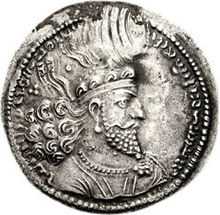Hormizd I
| Hormizd I | |
|---|---|
|
"King of kings of Iran and Aniran" (Middle Persian: šāhān šāh ērān ud anērān) "Great king of Armenians"[1] | |
 Coin of Hormizd I. | |
| Reign | May 270 – June 271 |
| Born | Unknown |
| Died | June 271 |
| Place of death | Unknown |
| Predecessor | Shapur I |
| Successor | Bahram I |
| Issue | Hormozdak |
| Royal House | House of Sasan |
| Father | Shapur I |
| Mother | Gurdzad |
| Religious beliefs | Zoroastrianism |
Hormizd I (Persian: هرمز یکم ), was the third King of the Sasanian Empire from May 270 to June 271.[2]
He was the youngest son of Shapur I (240–270/72),[3] under whom he was governor of Khorasan, and appears in his wars against Rome (Historia Augusta, Trig. Tyr. 2, where Nöldeke has corrected the name Odomastes into Oromastes, i.e. Hormizd).
In the Persian tradition of the history of Ardashir I (226–240 [died 241/42]), preserved in a Pahlavi text (Nöldeke, Geschichte des Artachsir I. Papakan), Hormizd I is made the son of a daughter of Mithrak, a Persian dynast, whose family Ardashir had extirpated because the Magi had predicted that the restorer of the empire of Persia would come from his blood.
According to legend, this daughter alone was saved by a peasant; Shapur I saw her and made her his wife, and afterwards her son Hormizd I was recognized and acknowledged by Ardashir. In this legend, which has also been partially preserved in Tabari, the great conquests of Shapur I are transferred to Hormizd I. In reality he reigned only one year and ten days.
References
 This article incorporates text from a publication now in the public domain: Chisholm, Hugh, ed. (1911). Encyclopædia Britannica (11th ed.). Cambridge University Press
This article incorporates text from a publication now in the public domain: Chisholm, Hugh, ed. (1911). Encyclopædia Britannica (11th ed.). Cambridge University Press
| Hormizd I Sassanid dynasty | ||
| Preceded by Shapur I |
Great King (Shah) of Persia 270–271 |
Succeeded by Bahram I |
| ||||||||